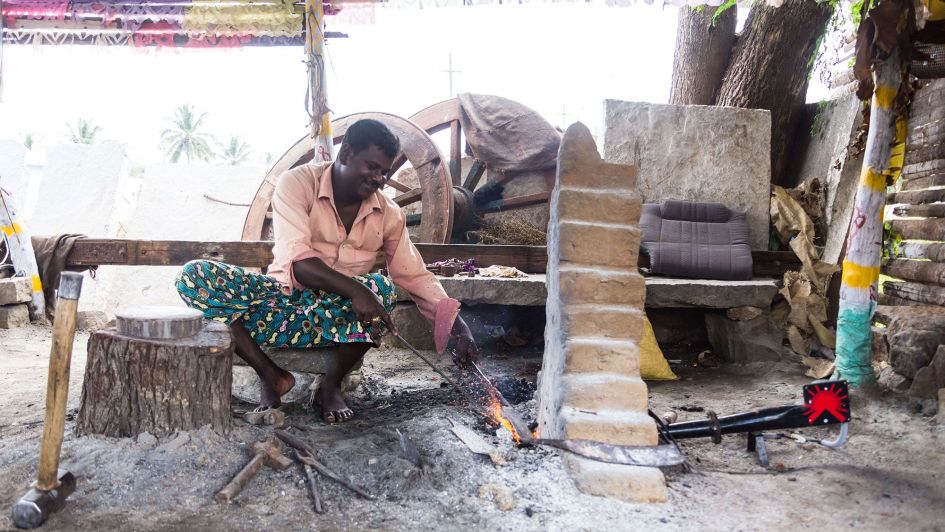A small dusty path leads to a smoke-filled shed in Ajekar village, Karkala Taluk, Karnataka, India where a blacksmith sits huddled in front of a fire. The intensity of the fire is being controlled by a manual bellow which a laborer is toiling over. In the 40 degree summer sun while battling a shoulder ache, Krishna Achari takes more than an hour to make one sickle. Achari has been a blacksmith since the age of 15, when his father passed on the craft. This lineage can be traced through the entire history of his family and through most of the 7.5 million blacksmiths in the country.
India has caste-based generational occupations even today. Blacksmiths, potters, leather makers, butchers have these livelihoods ascribed to them at birth. And despite industrialization and mechanization in more developed countries, the dependence on traditional blacksmiths continues to thrive in India, as most farmers still use custom-made tools rather than standard ones. It is partly because many of the industrial products are not suitable for marginal and small farmers; also the tools have to be made considering specific land/soil characteristics.
Under every one of these professions, there are various types of craftsmen based on the kinds of products made, mobility, work spaces and tools used (see table below for further info). One such type of blacksmith is nomadic, traveling constantly on predefined routes making agri and household tools with manual blowers, hand cranked tools and manual angle grinders. Other types include small, mid and large scale blacksmiths where they hire labour and make all kinds of tools for agri , hardware, household and cultural tools from their own smithing workshops.
What role does technology have to play?
Blacksmiths like Achari undergo extreme drudgery, constant exposure to harmful fumes and long hours of work which makes this a hazardous occupation. Currently, blacksmiths use large wheels, hand cranked blowers, manually operated large compressors etc. that are utilized to maintain and regulate temperatures of the fire. The methods of igniting and keeping the furnace running add to the drudgery. They are also prone to work related injuries and other health issues. Many studies have reported that injuries both minor and major are common among blacksmiths and that results in loss of health, well-being and working days.
Achari’s case and the above-mentioned factors led SELCO Foundation to pursue the simple innovation of the solar powered DC blacksmith blower. The innovation kept in mind the need for an ergonomic design with suitable air flow control. The addition of a speed controller provides good airflow control to suit the size of the workpiece. The coupling pipe design was designed by Ramesh Achari, a blacksmith himself from Muniya during the first pilot. The blower allowed the reduction of labor, an increased productivity of 20-30%, an increase in income with reduction in operational costs by 45% and a stark improvement in health and wellbeing. Following this, a solar-powered power hammer and angle grinder were designed to further aid the blacksmith in reducing drudgery and labor costs and increasing impact
The role of affordable financing
Along with the technological innovation, affordable financing mechanisms and financial inclusion played a key role in adoption. Loans are designed in partnership with local financial institutions to match cash flow, so that the labor charges saved went towards the monthly installment along with additional earnings. There is no change in gross income but in the net income as there is the elimination of labor charges and operational costs, addition of EMI payment cost (offset) and increase in productivity. As the payback period for the solution is short (2-4 months) considering savings in labor cost, it is an affordable solution for blacksmiths.
Craftsmen such as blacksmiths endure lack of support, income, technological development, causing these professions to die out rapidly with the next generation preferring newer professions. The introduction of technology and financial innovation can change the dynamic. The future of blacksmithy relies on piecing together the ecosystem, scaling of blacksmiths from smithing workshops to larger fabrication units and allowing them to expand their craft.
For more on other ways distributed renewable energy can improve lives in rural lndia, see SELCO Foundation's new report: Sustainable Energy and Livelihoods: a Collection of 50 Livelihood Applications
